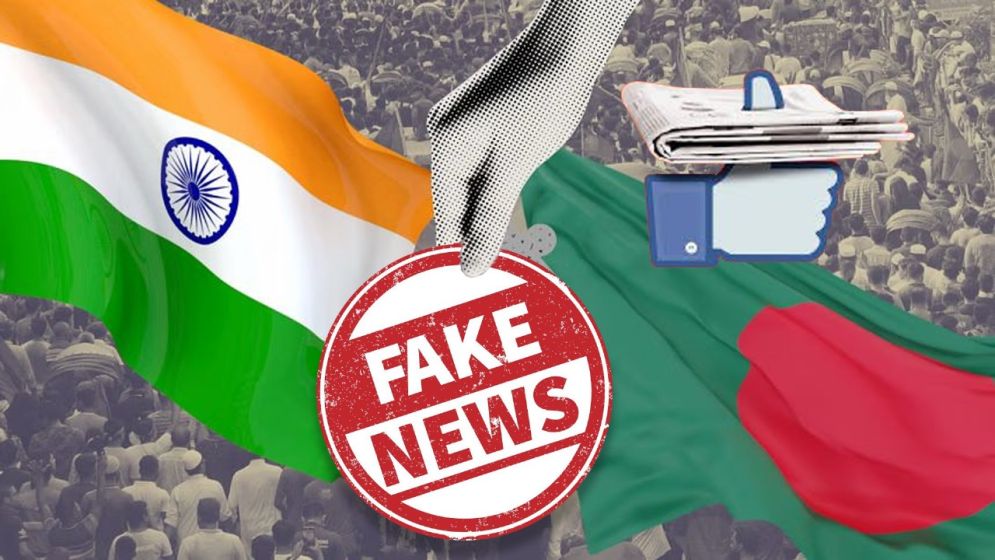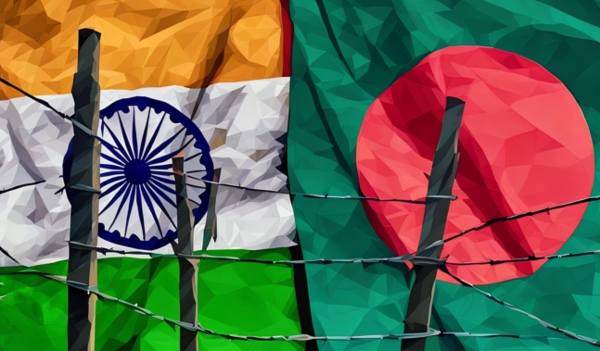Fixing ties or faking It? Why India’s “outreach” to Bangladesh rings hollow

New Delhi’s attempts at a diplomatic reset with Dhaka are less a carefully choreographed dance and more a cacophony of contradictions.
While official headlines sing of renewed friendship, the discordant notes of self-interest and historical condescension drown out any pretense of genuine rapprochement.
Take last month, for instance. The Hindu’s front page heralded a meeting of India’s Parliamentary Standing Committee on External Affairs, chaired by Congress MP Shashi Tharoor.
Four "top experts" huddled for over two hours, their collective wisdom culminating in a grand strategy to mend fractured ties: cultural diplomacy. Tagore, Nazrul, Bengali brotherhood–a nostalgic playlist dusted off from 1972, repackaged for 2025.
Yet, on that very same day, India quietly imposed new restrictions on seven key categories of Bangladeshi exports, stifling vital garment and other sectors. So much for "forward-looking policy."
The hypocrisy doesn’t end there. As the Ganges Water Treaty inches towards expiration, India now demands an additional 35,000 cusecs of water. Not for shared prosperity, mind you, but to satiate its own inflated needs, leaving Bangladesh’s farmers to face shrinking riverbeds and parched irrigation canals.
And who are the architects of this outreach? The cast of characters reads like a masterclass in moral gymnastics and historical amnesia.
There’s Shashi Tharoor himself, who, after the ignominious collapse of Bangladesh’s fascist regime and its dictator’s flight into Indian asylum, inexplicably defended her. This, from an opposition MP whose constitutional duty is to scrutinize, not shield, the government.
The Prime Minister in question oversaw the killing of 1,400 people, including over a hundred children, yet found sanctuary in India, rationalized by Tharoor under the convenient pretext of "Indian hospitality."
This alone exposes the hollowness of India’s diplomatic outreach. When the opposition enables tyranny, diplomacy devolves from statecraft into mere damage control.
Then there’s Shivshankar Menon, former Foreign Secretary and National Security Adviser. Recall 2011, when then-PM Manmohan Singh visited Dhaka to finalize the Teesta water deal, only for it to collapse after West Bengal CM Mamata Banerjee refused to agree.
Menon, it’s said, attempted to persuade Mamata in Kolkata with a brazen proposal: “Let’s just sign the deal—no need to actually give water.”
To which Mamata famously retorted, “This isn’t a joke. I won’t sign a hollow deal.” This is the same Menon now advising on Bangladesh relations.
-68660a4a8fc4c.png)
Undue vilifications
Riva Ganguly Das is cut from the same colonial cloth, a proud member of the infamous fraternity of former Indian High Commissioners to Bangladesh–Veena Sikri, Pinak Ranjan Chakraverty, Pankaj Saran, Harsh Vardhan Shringla–who built their careers on daily televised venom rather than on diplomacy.
Time and again, they painted Bangladesh as an “Islamic fundamentalist threat,” parroting the worn-out Indian playbook of fear and condescension. They spoke as though Bangladesh were a wayward Union Territory, not a sovereign nation.
With smirks and spins, they belittled Bangladesh’s people, mocked its independence, and questioned the legitimacy of its Interim Government.
And finally, the most disgraceful of the lot: Lt. General Syed Ata Hasnain. A rare case of a Muslim general in India who appears perpetually indebted to his Hindutva overlords, echoing their talking points with disturbing enthusiasm.
Once a soldier, he’s now a willing mouthpiece, a regular on India’s unhinged propaganda podcast circuit, particularly those hosted by the expelled loudmouth Major Gaurav Arya and the wildly erratic retired Lt. Gen. P.R. Shankar.
These two, walking embarrassments to any serious military tradition, spend their retirement like ranting adolescents glued to a webcam, obsessively spinning fantasies about invading Bangladesh–advocating for severing Rangpur in the north and Chattogram in the south as if drawing lines on a Risk board.
This unholy trio–Hasnain, Arya, and Shankar–has, since the collapse of Bangladesh’s fascist regime, treated the country like a new toy, prodding, poking, and projecting Hindutva paranoia through the lens of pseudo-strategy.
These men, once entrusted with military discipline, now peddle conspiracy, Islamophobia, and strategic delusion with the flair of overcaffeinated keyboard warriors.
Adding a veneer of academic gravitas to this shifting paranoia is Amitabh Mattoo, a prominent international relations scholar from Jawaharlal Nehru University (JNU). While his record isn’t marked by overt hostility toward Bangladesh, his sudden inclusion in this "expert" panel is no coincidence.
Mattoo’s core expertise lies in India’s strategic calculus, particularly concerning China and Pakistan. His involvement in a Bangladesh-focused task force signals what truly unnerves Delhi: the emerging contours of Bangladesh–Pakistan–China cooperation.
This isn’t simply about salvaging a lost sphere of influence under the guise of cultural friendship. It’s about confronting the stark reality that Dhaka may be decisively tilting away from South Block’s gravitational pull.
Mattoo’s role, therefore, is not to build bridges but to decode how to reassert dominance in a neighborhood India once believed it had locked down under the now-deposed Hasina regime.

Why the frenzy?
For too long, South Block felt securely encamped. Its prized asset was tucked away in a Lytton’s Garden bungalow, the Awami League’s top leadership hoarded and kept on standby with ample cash reserves.
Key BNP figures were brought into alignment–one of them groomed long in advance and now performing on cue–while the young and inexperienced NCPs were gradually reeled in through a blend of money and honey traps.
A handful of pliant generals remained within easy reach, and the illusion of control held firm.
But that comfort is visibly unraveling. Professor Yunus’s diplomatic outreach, followed by the recent foreign ministry–level meeting between Bangladesh, Pakistan, and China, and now the BNP’s unexpected summer vaults into Beijing’s diplomatic orbit–led by Mirza Fakhrul himself–have jolted Delhi into alert mode.
India is, rightly, interpreting them as clear signals that its traditional grip over Dhaka may have slipped further than ever anticipated. Bangladesh is recalibrating–quietly but decisively–and South Block can no longer afford the illusion of default obedience.
The fact is, the fall of India’s long-nurtured proxy regime in Bangladesh did not just trigger disappointment in Delhi–it sparked a full-spectrum retaliation campaign. The mask of diplomacy slipped, revealing a state apparatus in open panic, scrambling to retain its regional grip.
The most glaring act of complicity was obviously India’s open embrace of the deposed autocrat Hasina, granting her VIP refuge without the merest formality of a passport or official document.
The chorus of defense for Hasina was stunningly uniform, from the Ministry of External Affairs to opposition politicians, former diplomats to retired generals–all parroting the same lines in defense of the disgraced leader.
Simultaneously, India moved to stoke communal fires within Bangladesh. Hindu-aligned groups, notably ISKCON activists, emboldened by overt Indian backing, were activated to trigger unrest, culminating in the murder of a Muslim lawyer.
The timing was no accident; it was a deliberate injection of sectarian instability precisely when Bangladesh was navigating a fragile political transition.
In lockstep, India’s compliant media ecosystem, or "Godi Media," launched a coordinated propaganda barrage, maligning Bangladesh on minority rights.
They spun fiction into headlines, exporting false narratives through international lobbies, even going so far as to prompt a tweet from President-elect Trump against Bangladesh on minority persecution.
Beyond the domestic destabilization, the aggression manifested physically. Bangladeshi High Commission in Agartala was vandalized, and aggressive intimidation occurred in Kolkata–attacks on sovereignty brazenly masked as "public outrage."
Water, a shared lifeline, was weaponized: India unleashed flash floods into Bangladesh without prior data sharing, causing widespread destruction across northern districts–a callous act of hydro-hegemony devoid of remorse.
Along the border, instead of de-escalation, India intensified its aggression, erecting fences illegally and carrying out multiple civilian killings, sending a clear message of intimidation cloaked in "security enforcement."

No insulation on diplomacy
Diplomatically, India waged an open campaign to delegitimize Bangladesh’s Interim Government.
From television pundits to official spokespeople, Delhi consistently refused to recognize its legitimacy, despite its broad-based public support at home and unanimous endorsement from the international community.
India stood isolated in its stance, clinging to its discredited proxy, while the rest of the world acknowledged the new political reality. Despite repeated outreach attempts by Professor Muhammad Yunus, India refused to grant a formal meeting, even on the sidelines of international events.
At BIMSTEC, when a reluctant handshake did occur, India flatly denied the statement issued by Bangladesh, highlighting its recalcitrance.
At international forums, including Prime Minister Modi’s White House visit, India attempted to paint Bangladesh as an emerging Islamist threat–a calculated smear campaign designed to justify past meddling and future interference.
On the ground, medical and visa blackmail became a tool of political pressure, with India stopping the issuance of visas to Bangladeshis, particularly medical travel visas, weaponizing humanitarian access.
Indian politicians and officials–both ruling and opposition, including the press–continued to brazenly comment on Bangladesh’s internal affairs, violating every norm of bilateral respect.
Perhaps most tellingly, India continues to refuse to extradite Sheikh Hasina or acknowledge her destabilizing remarks from exile, effectively sheltering a fugitive and refusing accountability for hosting her provocations.
Economically, Delhi moved to block the transshipment of Bangladeshi garments via Indian airports to European markets, choking a key export sector just as economic recovery was underway.
After fifteen years of unequivocally backing a fascist regime, India now performs a diplomatic pirouette, hypocritically demanding democratic elections—an act that deceives no one.
After long years of waging economic sabotage, manipulating internal politics, and treating Bangladesh like a satellite state, India now brazenly attempts to peddle "cultural diplomacy" as its grand reset strategy.
A so-called soft power task force, packed with familiar ideological actors, proposes Tagore, Nazrul, and Bengali brotherhood as mere Band-Aids for decades of hegemony, coercion, and betrayal. Is this truly the pinnacle of India’s strategic thinking?
A 1972 playbook for a 2025 reality? The irony is grotesque.
In 1972, India leveraged culture to mold a Muslim-majority Bangladesh into adopting secular aesthetics, seemingly divorcing it from its Islamic roots. That experiment came at the cost of faith, language independence, and economic sovereignty.
It worked briefly, largely because Bangladesh was weak. But in 2025, Bangladesh is no longer naive; it has been burned enough times to understand precisely what Indian hegemony looks like, and what it truly costs.

Long history of oppression
Over the past 53 years, Bangladesh has lived under the oppressive shadow of systematic Indian interference–a quiet domination carefully disguised in the rhetoric of “eternal friendship.”
What many now recognize as structural betrayal was embedded from the very beginning, through a wartime secret seven-point agreement that laid out a disturbing blueprint for transforming a newly liberated country into a vessel state.
According to that plan, only "freedom fighters" approved by India would be absorbed into government roles, while the remaining administrative machinery would be staffed by Indian bureaucrats.
Bangladesh was to have no independent army–only a paramilitary force, which later manifested as the notorious Rakkhi Bahini. The Indian Army would remain stationed indefinitely.
The Bangladesh foreign ministry would operate through its Indian counterpart, and all trade would be conducted on an open-border basis with annual payments settled in pound sterling.
Even the Liberation War itself would be officially led not by the Mukti Bahini, but by the Indian Army. This insidious agreement was later sanitized and formalized as the 25-year "Friendship" Treaty of 1972–a document that, in reality, institutionalized India’s iron grip over Bangladesh’s nascent sovereignty.
In the immediate aftermath of 1971, India systematically looted Bangladesh, stripping the newly liberated country of critical assets. Indian forces seized all abandoned Pakistani military equipment, industrial machinery from factories, all public and private vehicles, and even household appliances.
What was left behind was not a liberated economy, but a gutted one—deprived of the very tools needed to rebuild. The so-called liberator walked away not as a friend, but as the first looter of the new republic.
Post-war, save for a brief window between 1975 and 1981, Bangladesh remained ensnared in a relentless cycle of Indian overreach that permeated every vital sector.
Of the 54 rivers shared between the two nations, India’s upstream greed has systematically choked Bangladesh’s agriculture, destroying water flow and crippling 80% of its farmlands.
The military establishment has stood by as India quietly sabotaged Bangladesh’s defense capacity–first by blocking independent arms procurements, and later through psychological warfare, exemplified by the 2009 BDR massacre.

Why will
the same playbook not work?
On the political front, Delhi's engineering has been relentless–implanting puppets, co-opting opposition leaders, and manipulating transitional phases to forcefully shape governance outcomes.
Economic sabotage has arrived in waves–through tariffs, trade route restrictions, export manipulation, and pressure on policymaking–all strategically undermining Bangladesh’s self-sufficiency.
To the West, India peddled a self-serving lie: branding Bangladesh as a breeding ground for Islamic extremism, conveniently ignoring its long record of religious tolerance, merely to keep Dhaka under perpetual diplomatic suspicion and surveillance.
Worse still, India has engaged in demographic warfare, pushing its Bengali-speaking Muslim population into Bangladesh to offload domestic tensions–later branding them “illegal migrants” or even “termites,” and blaming Bangladesh for the fallout.
It orchestrated the Rohingya influx to further destabilize border regions, while callously refusing to share the humanitarian burden.
And most dangerously, it injected false narratives through proxy political parties, suppressing dissent, hijacking institutions, and helping construct a monstrous fascist regime to serve Delhi’s geopolitical interests.
This isn't a list; it’s a multi-decade ledger of exploitation, deceit, and trauma.
Now, after decades of meddling, manipulation, and manufactured suffering, India’s proposal to “relaunch ties” with Bangladesh through cultural engagement isn’t just laughable–it’s deeply insulting.
Not just to Bangladesh, but to West Bengal as well. You don’t burn a house to the ground and return offering poetry. You don’t bankroll a tyrant, undermine a democracy, and then show up humming Rabindra Sangeet as if memory can be wiped clean with melody.
Before deploying "soft diplomacy," New Delhi should have looked inward–honestly, painfully–at the role it played in Bangladesh’s agony. A real reset begins with accountability, not abstract aesthetics.
And at this point, even dialogue is suspect, and rightly so. You cannot extend a hand while simultaneously tightening your grip. Delhi’s forked-tongue approach–offering songs while squeezing sovereignty–is an affront to Bangladesh’s intelligence, and frankly, a diplomatic farce.
To the Indian strategists still fumbling around Dhaka’s periphery: this isn’t 2009. This is a post-Hasina Bangladesh. A post-betrayal Bangladesh. A country that has seen the puppet strings and now knows exactly where they lead.
And let’s be blunt–India’s sudden urge to “repair relations” has absolutely nothing to do with goodwill. For ten months, Delhi refused to even acknowledge the interim government, hiding behind the convenient rhetoric of “only dealing with an elected regime.”
Now, with Sheikh Hasina’s trial accelerating, and the chilling possibility of names, complicity, and secrets emerging, India is squirming.
But Dhaka sees through it. Your transparent attempt to reclaim lost influence is not just too little, too late–it's too transparent to ever work.
—-
Omar Faris is a writer and analyst

